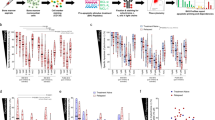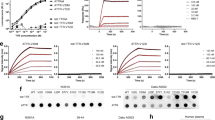Abstract
Amyloid light chain (AL) amyloidosis is a rare hematologic disorder characterized by the accumulation of a misfolded monoclonal immunoglobulin (Ig) light chain (LC) as fibrillar protein deposits. Current treatments, including cytotoxic chemotherapy and immunomodulatory therapy, are directed at killing the plasma cells that produce the LCs, but have significant toxicity for other cell types. We have designed small interfering RNAs (siRNAs) targeting the amyloidogenic LC messenger RNA (mRNA) in order to reduce expression of the amyloid precursor protein. Using nanomolar concentrations of siRNAs, we have inhibited synthesis of LC in transfected cells in vitro in a dose-dependent fashion. Furthermore, in an in vivo plasmacytoma mouse model of AL amyloidosis, we have demonstrated that these siRNAs can significantly reduce local production and circulating levels of LC. This model system highlights the therapeutic potential of siRNA for AL amyloidosis.
This is a preview of subscription content, access via your institution
Access options
Subscribe to this journal
Receive 12 print issues and online access
$259.00 per year
only $21.58 per issue
Buy this article
- Purchase on Springer Link
- Instant access to full article PDF
Prices may be subject to local taxes which are calculated during checkout




Similar content being viewed by others

References
Merlini G, Bellotti V . Molecular mechanisms of amyloidosis. N Eng J Med 2003; 349: 583–596.
Sanchorawala V . Light-chain (AL) amyloidosis: diagnosis and treatment. Clin J Am Soc Nephrol 2006; 1: 1331–1341.
Dispenzieri A, Lacy MQ, Rajkumar SV, Geyer SM, Witzig TE, Fonseca R et al. Poor tolerance to high doses of thalidomide in patients with primary systemic amyloidosis. Amyloid 2003; 10: 257–261.
Sanchorawala V, Wright DG, Rosenzweig M, Finn KT, Fennessey S, Zeldis JB et al. Lenalidomide and dexamethasone in the treatment of AL amyloidosis: results of a phase 2 trial. Blood 2007; 109: 492–496.
Sanchorawala V, Wright DG, Quillen K, Finn KT, Dember LM, Berk JL et al. Tandem cycles of high-dose melphalan and autologous stem cell transplantation increases the response rate in AL amyloidosis. Bone Marrow Transplant 2007; 40: 607.
Dember LM, Hawkins PN, Hazenberg BP, Gorevic PD, Merlini G, Butrimiene I et al. Eprodisate for the treatment of renal disease in AA amyloidosis. N Eng J Med 2007; 356: 2349–2360.
Tojo K, Sekijima Y, Kelly JW, Ikeda S . Diflunisal stabilizes familial amyloid polyneuropathy-associated transthyretin variant tetramers in serum against dissociation required for amyloidogenesis. Neurosci Res 2006; 56: 441–449.
Dykxhoorn DM, Lieberman J . The silent revolution: RNA interference as basic biology, research tool, and therapeutic. Annu Rev Med 2005; 56: 401–423.
Zamore PD . RNA interference: big applause for silencing in Stockholm. Cell 2006; 127: 1083–1086.
Benson MD, Kluve-Beckerman B, Zeldenrust SR, Siesky AM, Bodenmiller DM, Showalter AD et al. Targeted suppression of an amyloidogenic transthyretin with antisense oligonucleotides. Muscle Nerve 2006; 33: 609–618.
Semple SC, Akinc A, Chen J, Sandhu AP, Mui BL, Cho CK et al. Rational design of cationic lipids for siRNA delivery. Nat Biotechnol 2010; 28: 172–176.
Senechal Y, Kelly PH, Cryan JF, Natt F, Dev KK . Amyloid precursor protein knockdown by siRNA impairs spontaneous alternation in adult mice. J Neurochem 2007; 102: 1928–1940.
Rodriguez-Lebron E, Gouvion CM, Moore SA, Davidson BL, Paulson HL . Allele-specific RNAi mitigates phenotypic progression in a transgenic model of Alzheimer's disease. Mol Ther 2009; 17: 1563–1573.
DiFiglia M, Sena-Esteves M, Chase K, Sapp E, Pfister E, Sass M et al. Therapeutic silencing of mutant huntingtin with siRNA attenuates striatal and cortical neuropathology and behavioral deficits. Proc Nat Acad Sci USA 2007; 104: 17204–17209.
Pfister EL, Kennington L, Straubhaar J, Wagh S, Liu W, DiFiglia M et al. Five siRNAs targeting three SNPs may provide therapy for three-quarters of Huntington's disease patients. Curr Biol 2009; 19: 774–778.
Fountaine TM, Wade-Martins R . RNA interference-mediated knockdown of alpha-synuclein protects human dopaminergic neuroblastoma cells from MPP(+) toxicity and reduces dopamine transport. J Neurosci Res 2007; 85: 351–363.
White MD, Farmer M, Mirabile I, Brandner S, Collinge J, Mallucci GR . Single treatment with RNAi against prion protein rescues early neuronal dysfunction and prolongs survival in mice with prion disease. Proc Natl Acad Sci USA 2008; 105: 10238–10243.
Sutou S, Kunishi M, Kudo T, Wongsrikeao P, Miyagishi M, Otoi T . Knockdown of the bovine prion gene PRNP by RNA interference (RNAi) technology. BMC Biotechnol 2007; 7: 44.
Bodi K, Prokaeva T, Spencer B, Eberhard M, Connors LH, Seldin DC . AL-Base: a visual platform analysis tool for the study of amyloidogenic immunoglobulin light chain sequences. Amyloid 2009; 16: 1–8.
Ward J, Brenner D, Soo Hoo P, Cui L, Liao R, Ping X et al. Mouse models of AL amyloidosis. In: al. MSe (ed). XIth International Symposium of Amyloidosis. Taylor & Francis: Boca Raton, 2008. pp 321–323.
Golzio M, Mazzolini L, Ledoux A, Paganin A, Izard M, Hellaudais L et al. In vivo gene silencing in solid tumors by targeted electrically mediated siRNA delivery. Gene Therapy 2007; 14: 752–759.
Nakai N, Kishida T, Shin-Ya M, Imanishi J, Ueda Y, Kishimoto S et al. Therapeutic RNA interference of malignant melanoma by electrotransfer of small interfering RNA targeting Mitf. Gene Therapy 2007; 14: 357–365.
Cemazar M, Sersa G, Wilson J, Tozer GM, Hart SL, Grosel A et al. Effective gene transfer to solid tumors using different nonviral gene delivery techniques: electroporation, liposomes, and integrin-targeted vector. Cancer Gene Ther 2002; 9: 399–406.
van Gameren I, van Rijswijk MH, Bijzet J, Vellenga E, Hazenberg BP . Histological regression of amyloid in AL amyloidosis is exclusively seen after normalization of serum free light chain. Haematologica 2009; 94: 1094–1100.
Sanchorawala V, Seldin DC, Magnani B, Skinner M, Wright DG . Serum free light-chain responses after high-dose intravenous melphalan and autologous stem cell transplantation for AL (primary) amyloidosis. Bone Marrow Transplant 2005; 36: 597–600.
Phipps JE, Kestler DP, Foster JS, Kennel SJ, Donnell R, Weiss DT et al. Inhibition of pathologic immunoglobulin-free light chain production by small interfering RNA molecules. Exp Hematol 2010; 38: 1006–1013.
Ohno S, Yoshimoto M, Honda S, Miyachi S, Ishida T, Itoh F et al. The antisense approach in amyloid light chain amyloidosis: identification of monoclonal Ig and inhibition of its production by antisense oligonucleotides in in vitro and in vivo models. J Immunol 2002; 169: 4039–4045.
Birmingham A, Anderson E, Sullivan K, Reynolds A, Boese Q, Leake D et al. A protocol for designing siRNAs with high functionality and specificity. Nat Protoc 2007; 2: 2068–2078.
Shukla S, Sumaria CS, Pradeepkumar PI . Exploring chemical modifications for siRNA therapeutics: a structural and functional outlook. ChemMedChem 2009; 5: 328–349.
Whitehead KA, Langer R, Anderson DG . Knocking down barriers: advances in siRNA delivery. Nat Rev 2009; 8: 129–138.
Singh SK, Hajeri PB . siRNAs: their potential as therapeutic agents--Part II. Methods of delivery. Drug Discov Today 2009; 14: 859–865.
Sanderson RD, Borset M . Syndecan-1 in B lymphoid malignancies. Ann Hematol 2002; 81: 125–135.
Ward J, Brenner D, Eberhard J, Liao R, Connors L, O'Hara C et al. In vitro and in vivo mouse models for AL amyloidosis. In: G Grateau RK, M Skinner, (eds). Amyloid and Amyloidosis. CRC Press: Boca Raton, 2005. pp 64–66.
Mombaerts P, Iacomini J, Johnson RS, Herrup K, Tonegawa S, Papaioannou VE . RAG-1-deficient mice have no mature B and T lymphocytes. Cell 1992; 68: 869–877.
Yuan JS, Reed A, Chen F, Stewart Jr CN . Statistical analysis of real-time PCR data. BMC Bioinformatics 2006; 7: 85.
Livak KJ, Schmittgen TD . Analysis of relative gene expression data using real-time quantitative PCR and the 2(-Delta Delta C(T)) Method. Methods 2001; 25: 402–408.
Acknowledgements
Support for this study was provided by Hematology Training Grant T32 HL007501, P01 HL68705, the David S Levine Amyloid Research Fund and gifts from the Gruss and Wildflower Foundations. Special thanks to Kip Bodi and Anna Badiee for their help with bioinformatics, Tucker Berk for his help with immunoblots and IVEP and Dr Tatiana Prokaeva for her help with light chain sequence information.
Author information
Authors and Affiliations
Corresponding author
Ethics declarations
Competing interests
The authors declare no conflict of interest.
Rights and permissions
About this article
Cite this article
Hovey, B., Ward, J., Soo Hoo, P. et al. Preclinical development of siRNA therapeutics for AL amyloidosis. Gene Ther 18, 1150–1156 (2011). https://doi.org/10.1038/gt.2011.69
Received:
Accepted:
Published:
Issue Date:
DOI: https://doi.org/10.1038/gt.2011.69
Keywords
This article is cited by
-
Systemic amyloidosis: moving into the spotlight
Leukemia (2020)
-
A novel xenograft mouse model for testing approaches targeting human kappa light-chain diseases
Gene Therapy (2019)
-
Hematological Malignancies and Arterial Thromboembolism
Indian Journal of Hematology and Blood Transfusion (2019)
-
Animal models of monoclonal immunoglobulin-related renal diseases
Nature Reviews Nephrology (2018)
-
siRNA targeting the κ light chain constant region: preclinical testing of an approach to nonfibrillar and fibrillar light chain deposition diseases
Gene Therapy (2016)


